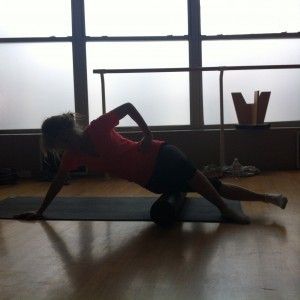When it comes to fighting soreness, boosting recovery, and getting the body prepped for a workout, foam rolling can’t be beat (at least until we invent affordable massaging robots). Foam rolling is a cheap and effective form of self-myofascial release. It helps loosen muscles and promote mobility, making it a smart — if occasionally painful — way to up anyone’s fitness game. So when Greatist learned about an entire class dedicated to the practice, we rolled on down to CLAY in New York City for a lesson in the art of self-massage.
Photo by Jordan Shakeshaft
While foam rolling is something we recommend every fitness aficionado learns — we even made a how-to infographic about it — some expert instruction can definitely help push through the, er, more uncomfortable moments. Our instructor, Michael McArdle (who also teaches yoga and produced a yoga DVD with Bethenny Frankel), started us off with a brief intro to the concept then asked if anyone in our group was a regular roller. I enthusiastically raised my hand only to grimace when McArdle handed me a three-foot long cylinder — covered in rubber spikes. While everyone else in the class got a conventional roller, the Rumble Roller, he explained, is especially effective at loosening muscles for those more experienced with self-myofascial release.
McArdle spent the next hour guiding us through various positions and movements with our rollers, hitting trouble spots from the calves through the upper back. Internally and externally rotating joints while rolling provided a new level of intensity many of us seasoned rollers hadn’t experienced before. For those with injuries or mobility limitations, McArdle provided some simple modifications. Almost all of us were shocked when McArdle has us roll out one hip and then do some simple bodyweight movements like leg raises; the flexibility difference was almost comical.
After an hour of teeth-gritting fun (that was anything but graceful), we had both sides loosened up — and I had a few tears in my eyes. McArdle congratulated me on sticking with the Rumble Roller for the entire hour-long session, a decision he assured me would pay off in the long run. Foam rolling isn’t always the most pleasant process, but when it comes to helping the body recover and rebuild, a little grit can make all the difference.
Interested in Rolling Grace? Check out CLAY’s website to learn more about the class and facility. Michael also teaches yoga classes around New York City, so check out his schedule here to get stretched out in a much different (and maybe less painful?) way.
Are you a foam rolling aficionado? Any favorite rolling techniques? Let us know in the comments below or tweet the author @d_tao.


